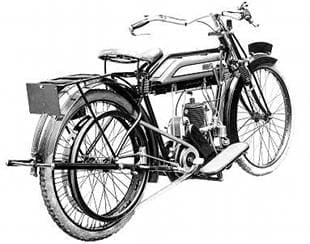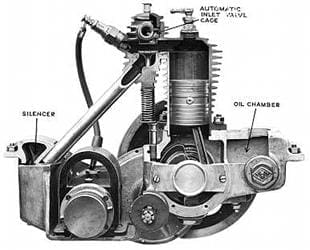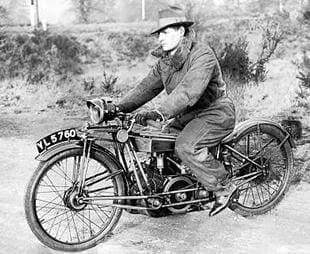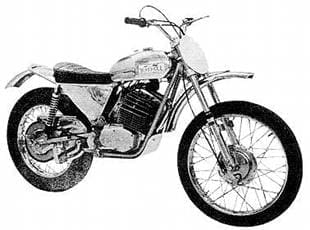
Vindec 1902 -29 UK
Parts and cycle suppliers to the trade and later motor and motorcycle parts and accessories factors, Brown Brothers Ltd of Great Eastern Street, London, entered the motorcycle world with the Vindec brand in 1902. Brown Bros also marketed machines under the Brown label during 1902-19.
As Brown Brothers were trade wholesalers it’s doubtful they actually built any machines, although they may have assembled kits. Instead they would have applied their marque transfers to motorcycles built on their behalf by other makers.
During the veteran period the Vindec brand took a back seat to the Brown range suggesting few Vindecs were built until c1913/14. For 1914 two models were listed, a 225cc two-stroke single, seemingly derived from the 225cc two-stroke James. Transmission options included a two-speed gearbox although history suggests a direct drive version was on offer. The second Vindec on offer for 1914 was a 4hp V-twin, by the 1916 season the 4hp engine was replaced by 6hp V-twin unit which was marketed with a three-speed Sturmey Archer gearbox, kick start and belt final drive.
Brown Bros dropped the Brown brand in 1919, re-entering the motorcycle market after WWI with just Vindec motorcycles. Supply of machines, again made on Brown Bros behalf by rival factories, began in 1919 with the 225cc lightweight range, which was soon joined by a 976cc side-valve JAP V-twin powered model for both solo and sidecar applications. The two-stroke was dropped in favour of a 293cc side-valve JAP powered lightweight for the 1922 season. The big V-twin was dropped from the trade guides for 1924 when a 170cc two-stroke ultra lightweight appeared.
Briefly, the 976cc V-twin reappeared in the mid-Twenties, then was dropped along with the 170cc lightweight in favour of a 147cc Villiers powered job, which was listed for less than a season, leaving just the 300c JAP lightweight to continue until 1929. A small range of Mills and Fulford sidecars were marketed on and off under the Vindec brand, also under the Brown label. Brown Bros continued to list sidecars after motorcycle marketing ended although for the most part these were for cycles rather than motorcycles.
Vindec Special 1903-09, VS 1909-14 UK
More fascinating history from the veteran period, which has nothing directly to do with the Vindec marketed by Brown Bros, although problems regarding the registered Vindec mark linked the two in branding battles. William Huntington (Billy) Wells of Maine, USA moved to the UK to sell the American Prescott twin-cylinder steam car (1901-05) built by AL Prescott who was also responsible for Enameline stove polish. Billy joined the South British Trading Company (SBT), which was established primarily to promote American products and businesses in the UK as manager of their new motor depart. Soon, Wells was approached by the Koln Lindenthaler Motorenwerke AG, Cologne maker of the Allright range of motorcycles to import their machines to Britain.
After trying unsuccessfully to claim the name Vindec in the UK, which Brown Bros had already registered, further variations on the Vindec theme were tried before Vindec Special was found unregistered. Allright produced an FN powered 23⁄4hp model with SBT cast into the crankcases in readiness for the 1903 Stanley Show held in London.
An option of Trufault front fork as soon available and in 1904 Billy Wells, who at well over 6ft tall, dwarfed the tiny Vindec Special, secured a Gold in the year’s London-Edinburgh trail. Wells finished second in the 1907 multi-cylinder class of the IoM TT riding a V-twin Vindec-Special with an identical Peugeot engine to that of class winner Rem Fowler’s Norton.
On 25 February 1908 Oscar Bickford lined up his 5hp 670cc Peugeot Vindec-Special against the Triumph single of W Gordon McMinnies (both Magdelen College, Oxford undergraduates) in the first ever motorcycle race at Brooklands – McMinnies won. Vindec-Specials, often with Peugeot engines, became early frontrunners at Brooklands. Riders included FH Arnott, ED Dickson, E Frasetti, FA Hardy and GG Mead. Vivian Olsson – also a Brooklands racer – established the first end-to-end (John o’Groats to Land’s End) sidecar record with his Vindec Special outfit.
By the close of 1910 the Vindec Special marque was a spent force as far as Brooklands was concerned. The motorcycles remained fine but behind the scenes the South British Trading Company had gone into liquidation in 1908, Brown Bros quickly bought the Vindec Special brand to prevent anyone else using it, thus when the makers of Allright re-established their London import depot they had to settle for the brand VS. Alongside this activity Billy Wells, who’d earlier tried to raise the cash to save the Vindec Special import operation, took over a sales campaign on behalf of Indian for UK, Europe and elsewhere. The American Hendee Manufacturing Company’s depot was established in the old Vindec Special (SBT) premises at Great Portland Street, London.
Despite building good quality motorcycles and investing a huge amount of cash to re-establish themselves in London during 1909, sales of VS machines was slow and promotion opportunities in competition events were missed. In turn, Billy Wells took his magic to Indian who scored a one, two, three in the 1911 IoM Senior TT. A number of single and V-twin Vindec Special and VS machines survive.
Viper (Viper 4) 1919-22 UK
Limited production of JAP powered models from 293cc side-valve singles with a ladies framed option to 1000cc V-twins. Little is known about this maker, although possibly two firms were involved. A few larger models survive hence their inclusion in this reference guide.
Viratelle 1907-24 France
Good quality maker from Lyon who installed a range of proprietary engines in often advanced rolling chassis. Also built a few machines with long wheelbase and employed all chain drive from the start of manufacture. A number of options were available including water cooling from 1907 enabling machines to be ridden harder than many rivals’ air cooled models with scant fins to their iron barrels.
Vittoria 1931-c80 Italy
Designed by Carnielli using predominantly bought in components, including at times frame kits. During the Thirties, Vittoria offered a range of machines from Sachs powered commuter lightweight through steady tourers to faster ohv models, both with either JAP or Kuchen engines. They also built a cracking faster roadster in the early Thirties with a 499cc Rudge Python in small numbers.
After WWII Vittoria concentrated on a range of two-stroke lightweights and delivery trikes. Odd examples of both post WWII lightweights and trikes surface, often at autojumbles, at modest prices.
Voskrod 1966 (c1950)- Russia
Brand name applied to Kovrov who built two-stroke lightweights for selected markets. Some sources suggest the name was applied to larger machines including a 350cc two-stroke twin and a horizontal flat twin. The first Kovrov built machine marketed as the Voskrod, had its design based on the loop scavenge DKW RT125 Later a 175cc version was built with updates focused on chassis and suspension design rather than the engine. Large numbers of 125/175cc machines were marketed as the Voskrod and a number survive in the UK.
Vulcaan (Vulkaan) 1911-17 (1927) Holland
Respected cycle maker from Venray who established a close business arrangement with Swiss proprietary engine maker Zurcher and Luthi who built Zedel engines. Using heavyweight lugs and tube from their cycle manufacturing operation to build frames, Vulcaan added sprung girder front forks when making their first Zedel powered direct belt drive machines. Later, some models had primitive gears and free engine facility.
Vulcaan then built Zedel engines at their Venray plant from parts supplied by Zurcher and Luthi. As WWI gripped Europe, supply of Zedel engines and parts stopped, leaving Vulcaan to struggle on making some engine parts themselves but by 1917 they’d exhausted the remaining stocks of Zedel parts they couldn’t fabricate, leading to an end of motorcycle production. They continued with cycle manufacture and imported British built machines until the late Twenties.
Vulcan 1921-23 UK
Two models were built by the Vulcan Works Ltd, Welshpool, a 250cc two-stroke model which their period Buyer’s Guide insert stated was of 255cc (68 x 70mm) but 67 x 70mm bore and stroke giving 247cc (Villiers dimensions) is more likely and a 293cc JAP powered model with options of Albion or Moss gearbox. Some of the two-stroke versions had a free engine facility operated by a top frame tube rather than handlebar mounted lever.
Vulcan 1904-24 Czechoslovakia
Another case of badge engineering as models were identical to Czech-built Perun machines. Range comprised single and V-twin motorcycles before WWI and cycle clip-on units after the war.
Wabo c1955-58 Holland
Dutch small volume maker of 99cc and 147cc two-stroke scooters powered by either the two-speed Villiers 4F or three-speed 30C engines. Another elusive find for the dedicated scooter fan.
Waddington 1902-06 UK
Pioneer maker, who for some time worked from premises at Middlesbrough. Using Aster, De Dion, Minerva and MMC engines, Waddington built motorcycles, forecars and a voiturette. Odd examples survive.
Waddon-Erlich 1981-83 UK
Also known as Waddon Rotax, and by the FIM, as Rotax Waddon. Two-stroke racing machines initially with design work by Austrian Dr Joe Erlich of post WWII EMC fame. Erlich soon left Waddon, who enjoyed a brief period of national and international success with their 250cc Rotax powered machines, including a win in the 1982 IoM 250cc TT ridden by Con Law, and championship points in the 1982 250cc GP series for Australian Graeme McGregor and Tony Head from the UK. Surviving Waddon racers could be bought for little money during the Nineties but now are enjoying a revival price wise having gained classic status in the eyes of many fans of historic racing motorcycles.
Walba 1949-52 Germany
Designed by Walter Baibaschewski, production began with a tiny 98cc Ilo powered scooter called the Walbo 100 with tiny wheels, yet the machine was surprisingly heavy. In 1950, the scooter design was much improved if imitation fake turbine and space like front mudguard styling is your thing, they retained Ilo 98cc engines. Model range comprised the 118cc Kurier, 122cc De-Luxe and 50mph 173cc Commadore. The Walba scooter range was again redesigned in 1952 retaining its fake jetpod styling. They were then built and marketed as the Faka (FAhrzeugwerk KAnnenberg).
WAG 1924-25 UK
There are no known survivors from a limited production run. Historically, WAG are one of few makers to use a two-stroke V-twin engine.
Wagner 1930-35 Czechoslovakia
Over their five year production run, Wagner introduced an extensive range of models including two-stroke lightweights from 98cc upwards and a range of larger machines with side-valve, ohv and ohc single cylinder engines of up to 500cc. Surviving ohv and ohc models now command strong prices.
Wagner 1909 (1901, 1904, 1905)-1914 USA
History of this maker is surrounded by doubt and half truths with many observers claiming their own take on Wagner manufacturing dates and model range is accurate. They are believed to have built single, parallel and possibly V-twin models with their own engines, which were occasionally supplemented with Thor units. Folklore tells us the designer’s 18-year-old daughter, Clara Wagner, rode a single cylinder model from Chicago to Indianapolis as a publicity stunt in 1910.
Wall 1909-15 (c1923) UK (USA)
Without doubt few motorcycles look more bizarre than Mr Wall’s Auto-Wheel, yet in this instance looks deceive. Although the device attracts its fair share of mirth from those who know no better, they powered many thousands of happy customers about their daily business and today, well fettled, carry half a dozen enthusiasts reliably to Brighton every March during the annual Sunbeam MCC Pioneer Run.
Towards the end of the Edwardian period Arthur Wall’s Roc motorcycle, gears and clutch business was in steady work at Hay Mills, Aston, Birmingham when Mr AW Wall designed and built an 80cc two-stroke Auto-Wheel which he displayed at the 1909 Stanley Show in London. Thanks to the backing of his brother-in-law Dr (later Sir) Arthur Conan-Doyle, author of the Sherlock Holmes tales, Wall was able to develop far more ideas into prototypes than many with rival businesses of a similar size.
It’s doubtful any 80cc Auto-Wheels were sold and a year later the machine’s engine had grown into a 160cc two-stroke twin. However, the basic layout, comprising an engine driving a 20 in wheel and fuel tank mounted to a sub-frame, remained similar. The entire attachment was flexibly mounted to an adult’s pedal cycle. The start of volume production of the Wall Auto-Wheel was announced in August 1912 by the International Auto-Wheel Co Ltd. Arthur Wall, who by then was occupied designing and building V-twin powered cyclecars, was no longer involved with the project.
Although the basic concept of the production model followed Arthur Wall’s initial idea, it was powered by an 118cc automatic inlet over mechanical side-exhaust valve single cylinder engine. Its barrel looking similar to one from a Belgian FN four. Although slow with a cruising speed of about 20mph the modestly priced Auto-Wheel found plenty of takers who could afford 16 guineas (£16.80) to power their pushbike and the majority weren’t disappointed.
Within a year, over 1700 Auto-Wheels had been sold, heady figures by pre WWI standards, and demand severely outstripped manufacturing capabilities leading the company to contract BSA to build 5000 units in double quick time. As WWI approached licences were granted for the manufacture of Auto-Wheels in many European countries including Belgium, France and Holland. And significantly a further licence was granted in autumn 1914 for manufacture to start in the USA where it was sold as the Smith’s Motor Wheel.
Despite the BSA contract doing well for both parties, once war began the Small Heath factory was given over to military contracts and Auto-Wheel work didn’t resume after WWI. Manufacture of the Smith’s Motor Wheel continued through the war in the USA and by 1922 arrangements were made to import them to the UK using the Wall Auto-Wheel’s London premises in Kensington, by which time its engine had grown to 206cc. In 1923 this arrangement ended and only a few new, old stock models remained to be shifted at knock down prices. Well in excess of 200 Auto-Wheels are believed to survive including a sizable number of veteran examples.
Wallis 1925-26 Wallis and Comerfords-Wallis 1929-c1931 UK
While working for the Harley-Davidson distributor in the UK Sir Duncan Watson, George Wallis became unimpressed by the heroics of Brooklands’ riders at high speed on the rough surfaced Weybridge Track when riding machines with girder front forks. He knew there was a better way. While building Harley-Davidson engines in the Brooklands’ Tuning sheds he evolved his idea of a hub centre steering system.
After leaving Duncan Watson and with financial backing from CG Underwood, Wallis set up in business at The Valley House, Queensmead Road, Bromley, Kent. With its inclined 350/500cc JAP or Blackburne engines giving a low centre of gravity, the Wallis impressed many including the press. Despite orders, racing success with Brooklands places and a steady 16th for Sid Crabtree in the 1926 Junior TT, the Wallis soon became a victim of the approaching recession. Despite a successful 1926 London Show a worried Underwood withdrew his backing and soon Wallis Motors Ltd were forced into voluntary liquidation before any show orders had been fulfilled.
Gaining a position selling American Henderson 4-cylinder motorcycles in the UK, George Wallis then became involved with the early British speedway scene via Motor Cycle editor Arthur Bourne. Initially, Wallis tuned 346cc Harley-Davidson Peashooters, which won races but broke frames leading him to develop his own speedway chassis. Initially, 344cc ohv JAP engines were fitted but George and others encouraged JAP to develop a 500cc ohv speedway engine, claiming his initial order of 100 engines swung the decision by the Tottenham engine maker.
Wallis entered a marketing and manufacturing agreement with Thames Ditton dealer Comerfords leading to the Comerfords-Wallis speedway machine which later became the Comerfords Special after the business agreement lapsed.
George spent 1931-33 running team workshops and mechanics for Crystal Palace, Stamford Bridge and then Plymouth speedway teams before breaking away from motorcycling for 25 years. During the late Sixties, holidayled inspiration encouraged Wallis to design a tiny commercial-type trike and then promote the idea to the BSA group. Triumph built a Tina scooter-based three-wheeler around Wallis concept then Umberslade Hall came up with the Ariel 3, which had little to do with the Wallis design. As the agreement with the BSA group expired, George took his design back from the British company and sold it to Japanese car-maker Daihatsu. The model was never imported into the UK.
Walter 1900-49 (1922-26) Czechoslovakia
Jinonice factory headed by Josef Walter who began building single cylinder motorcycles in 1900 later adding V-twins to their range. Walter usually fitted their own engines including the V-twins, which were later modified for three-wheeler applications. In 1913 Walter began building cars and then V-twin motorcycles for the Czech military during WWI alongside aircraft engines.
In 1917 Josef Zubaty led the Walter factory team to design a horizontal flat twin motorcycle, which never went into production, then Zubarty left the company. By 1922 Walter had been taken over by Itar and Walter company director Plocek introduced an ohv 746cc tansverse V-twin which was bought in some quantity by the Czechoslovakian military. Although the factory went on to build some ohv 1000cc V-twin racing machines, motorcycle manufacture was phased out as production levels of cars and aircraft engines increased.
At the time Itar took over the company he founded, Josef Walter left the Jinonice works to establish with his sons Jan and Jaroslav, another factory named Walter, to initially make gears, sprockets and associated items. By 1926 the father and sons Walter team had designed, developed and re-entered motorcycle production with a 496cc side-valve single cylinder machine. Further development continued and the Walters rekindled their interest in racing leading to the successful 1938 on 250cc ohv and ohc single cylinder racers designed by Jaroslav Walter. In 1947 a 350cc version was launched and both models did well at immediate post WWII mid European events. In 1949 Walter was taken over by CZ whom Jaroslav joined.
Surviving 250/350cc ohc Walter single cylinder racers are eagerly sought by racing motorcycle collectors who are willing to pay high prices for rare survivors.
Walter 1903-42 Germany
Motorcycle maker from Muhlhausen who assembled motorcycles and later autocycles from proprietary parts. Production began using Fafnir engines, by the mid-Twenties Villiers two-stroke engines were often used and in the mid-Thirties Walter offered autocycle-type machines with Ilo and Sachs units.
Wanderer 1902-29 Germany
For almost three decades Winkelhofer & Jaenicke built high quality motorcycles at their Saxony factory. Production began with single speed,, single cylinder models, often with 308cc automatic inlet valve engines. Then V-twins joined the range, mechanical side-valve replaced automatic inlet valve design, frames became stronger and by WWI some heavier models sported coil spring controlled pivot fork rear suspension. Wanderer supplied a 4hp, 504cc side-valve V-twin with three-speed gearbox to the German military during WWI.
New postwar models included an 185cc horizontal ohv single cylinder lightweight and a range of unit construction V-twins of side-valve and ohv design. Advanced concepts included four-valve cylinder heads for top of the range sporting models. Duplex frame design was employed for selected models and in some cases the engine was partially suspended from the frame.
With the depression approaching Wanderer launched an advanced ohv 498cc unit construction single. Its crankshaft ran in line with the frame for ease of shaft drive design. A contracting band handbrake operated on the drive system. Development costs for the new model forced Wanderer into liquidation before sales got going. NSU took over the factory, which then built Sachs powered two-stroke lightweights for a time while the design, equipment and drawings for the new 498cc shaft drive singles were sold to the Prague firm F Janacek who built and marketed it as the Janacek-Wanderer (JAWA).
Warwick 1923-24 UK
Small volume maker who used proprietary parts including 247cc Villiers Mk V1 or V11 engines, Burman gearboxes and Druid front forks. Most were belt drivers and a single sports model was made with dropped handlebars, which survives today.
Wassell 1970-75 UK
Well known motorcycle accessories suppliers Wassell, run by Ted (WE) Wassell began building BSA Bantam 175cc powered trials machines in 1970 often with rebuilt secondhand BSA engines. The Wassell Bantams used many of their own trade stock parts. When Bantam production ended the supply of engines, albeit predominantly secondhand ones, began to dry up, forcing Wassells to re-consider.
After looking at available ‘micro’ trials motorcycle options, including the 125cc Puch powered Dalesman, Wassell decided to become a volume manufacturer of 125cc scrambler, trials and enduro motorcycles.
Peter Edmondson joined the project from Dalesman as chief development engineer while Jim Lee, also from the Dalesman project, was responsible for making the frames. Although some sources suggest Wassell initially used Puch engines, this may have been for development only, if at all, as Edmondson and Tim (Ted’s son) Wassell soon opted for German built 125cc Sachs engines.
With Lee frame, Sachs engine, Rickman wheel hubs, Betor front forks and Hyde aluminium fuel tank, the Wassell was built with quality rather than economy in mind. Figures suggest in excess of 2000 Wassell 125s were built including over 1000 Antelope trials models. Although sold in the UK the majority of machines were exported to the USA where they were marketed as the Penton.



